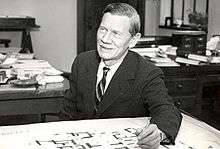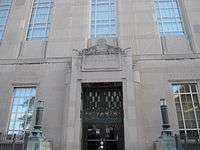Carl Blegen
| Carl Blegen | |
|---|---|
 Carl William Blegen | |
| Born |
Carl William Blegen January 27, 1887 Minneapolis, Minnesota |
| Died |
August 24, 1971 (aged 84) Athens, Greece |
| Occupation | Classical archaeologist |
| Spouse(s) | Elizabeth Denny Pierce |
Carl William Blegen (January 27, 1887 – August 24, 1971) was an American archaeologist who worked on the site of Pylos in Greece and Troy in modern-day Turkey. He directed the University of Cincinnati excavations of the mound of Hisarlik, the site of Troy, from 1932 to 1938.[1]
Background
Blegen was born in Minneapolis, Minnesota, the eldest of six children born to Anna Regine (1854–1925) and John H. Blegen (1851–1928), both of whom had emigrated from Lillehammer, Norway. His younger brother was noted historian Theodore C. Blegen. His father was a professor at Augsburg College in Minneapolis for more than 30 years and played a central role in the Norwegian Lutheran Church in America. Blegen earned his bachelor's degree from the University of Minnesota in 1904 and started graduate studies at Yale University in 1907.[2]
Career

In Greece, he was a fellow at the American School of Classical Studies at Athens (1911–1913), during which time he worked on excavations at Locris, Corinth and Korakou. During World War I Blegen was involved in relief work in Bulgaria and Macedonia, receiving the Saviors Order from Greece in 1919. Following the war he completed his Ph.D. at Yale (1920). He was then assistant director of the American School (1920–26); during his tenure he excavated at Zygouries, Phlius, Prosymna, and Hymettos. In 1927, Blegen joined the faculty of the University of Cincinnati. Blegen was professor of classical archaeology at the University of Cincinnati from 1927–1957. His excavations at Troy were carried out between 1932 and 1938, followed by those at the Palace of Nestor in Pylos, Greece in 1939 (the dig resumed 1952-1966). Many of the finds from this excavation are housed in the Archaeological Museum of Chora. Blegen retired in 1957.
He received honorary degrees from the University of Oslo and the University of Thessaloniki in 1951; an honorary D.Litt. from the University of Oxford in 1957 and an honorary LL.D. from the University of Cincinnati in 1958. Further honorary degrees came in 1963: Litt.D. from Cambridge, and others from the University of Athens, Hebrew Union College, Jewish Institute of Religion in Jerusalem. In 1965 Blegen became the first recipient of the Archaeological Institute of America's Gold Medal for archaeological achievement.[3]
The Carl Blegen Library is located on the campus of the University of Cincinnati. The library has curated an exhibit called Discovering Carl Blegen which includes images from Blegen’s major campaigns in Troy and Pylos as well as his work and life at UC and abroad. Blegen Library at the American School of Classical Studies at Athens is named also after Carl Blegen. Blegen Hall on the University of Minnesota Twin City Campus is named after his brother Theodore C. Blegen.[4][5]
Personal life
Asked how to pronounce his name, Blegen told The Literary Digest: "Seeking the pagan is Doctor Blegen (blay'gen).[6]
In 1924 he married Elizabeth Denny Pierce (1888–1966) in Lake Placid, New York, the two formed an unusual relationship with Bert Hodge Hill and Ida Thallon Hill that they called "the Quartet".[7] Carl Blegen died in Athens, Greece. Carl W. Blegen bequeathed a large collection of his documents to the American School of Classical Studies at Athens.[8][9]
Bibliography
- 1921. Korakou: A Prehistoric Settlement Near Corinth (The American School of Classical Studies at Athens)
- 1941. Studies in the Arts and Architecture (University of Pennsylvania)
- 1950-1958. Troy: Excavations Conducted by the University of Cincinnati, 1932–38, 4 vols.
- 1963. Troy and the Trojans (Praeger)[10]
- 1966-1973. The Palace of Nestor at Pylos in Western Messinia (with Marion Rawson. 3 vols.)[11]
Sources
- Petrakis, Susan L. Ayioryitika: The 1928 Excavations of Carl Blegen at a Neolithic to Early Helladic Settlement in Arcadia (INSTAP Academic Press. 2002)
- Blegen, Carl W. 2014. Carl W. Blegen: personal and archaelogical narratives. Lockwood Press.
External links
- New Title from ISD and Lockwood Press -- Carl W. Blegen: Personal and Archaeological Narratives [12]
- Blegen Library at the American School of Classical Studies at Athens
- Carl Blegen Library at the University of Cincinnati
- Finding Aid for Carl W. Blegen papers, Archives and Rare Books Library, University of Cincinnati, Cincinnati, Ohio
References
- ↑ "Carl William Blegen (Store norske leksikon)". Snl.no. Retrieved 2012-09-16.
- ↑ "John H. Blegen (Store norske leksikon)". Snl.no. 1928-02-09. Retrieved 2012-09-16.
- ↑ "Gold Medal Award for Distinguished Archaeological Achievement". Archaeological Institute of America. Archived from the original on September 25, 2007. Retrieved 7 April 2010.
- ↑ "Carl Blegen Library (Department of Classics)". Classics.uc.edu. Retrieved 2012-09-16.
- ↑ Carl William Blegen Papers (The American School of Classical Studies at Athens) Archived October 1, 2005, at the Wayback Machine.
- ↑ What's the Name, Please?(Charles Earle Funk, Funk & Wagnalls, 1936)
- ↑ Bolster, Ruth. "Blegens leave unconventional legacy as scholars and family". The Miscellany News. Vassar College (Newspaper). Archived from the original on 12 April 2011. Retrieved 25 April 2011.
- ↑ "Elizabeth Pierce Blegen (American School of Classical Studies at Athens)". Ascsa.edu.gr. Retrieved 2012-09-16.
- ↑ "Carl William Blegen Papers (American School of Classical Studies at Athens)". Ascsa.edu.gr. Retrieved 2012-09-16.
- ↑ Carl W. Blegen (1995). Troy and the Trojans. Barnes & Noble Books. ISBN 978-1-56619-823-3.
- ↑ Mabel L. Lang; University of Cincinnati (1969). The Palace of Nestor at Pylos in Western Messenia: The frescoes, by M. L. Lang. Published for the University of Cincinnati by Princeton University Press.
- ↑ Vogeikoff-Brogan, Natalia; Davis, Jack L.; Florou, Vasiliki (January 2015). Carl W. Blegen: Personal and Archaeological Narratives. Lockwood Press. ISBN 9781937040222.